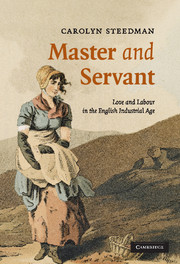Book contents
- Frontmatter
- Contents
- List of maps
- Acknowledgements
- Map 1 Map of the Haworth, Slaithwaite, Huddersfield and Halifax region, 1795
- Map 2 Sketch map of the woollen and worsted producing areas of the West Riding, late eighteenth century
- Prologue
- 1 Introduction: on service and silences
- 2 Wool, worsted and the working class: myths of origin
- 3 Lives and writing
- 4 Labour
- 5 Working for a living
- 6 Teaching
- 7 Relations
- 8 The Gods
- 9 Love
- 10 Nelly's version
- 11 Conclusion: Phoebe in Arcadia
- Bibliography
- Index
5 - Working for a living
Published online by Cambridge University Press: 06 January 2010
- Frontmatter
- Contents
- List of maps
- Acknowledgements
- Map 1 Map of the Haworth, Slaithwaite, Huddersfield and Halifax region, 1795
- Map 2 Sketch map of the woollen and worsted producing areas of the West Riding, late eighteenth century
- Prologue
- 1 Introduction: on service and silences
- 2 Wool, worsted and the working class: myths of origin
- 3 Lives and writing
- 4 Labour
- 5 Working for a living
- 6 Teaching
- 7 Relations
- 8 The Gods
- 9 Love
- 10 Nelly's version
- 11 Conclusion: Phoebe in Arcadia
- Bibliography
- Index
Summary
In some abstract realm of legal theory and political philosophising, Phoebe Beatson exercised John Murgatroyd's capacity to labour: she was an aspect of his legal personality, not he of hers. When she planted, and tended, and harvested the peas and beans in the kitchen garden, she turned his labour capacity into an object of use and consumption. He used no proxy in exercising his own energies and capacities in the service of the Church of England over an extraordinarily long period of time, in holy orders and as parochial schoolmaster. This was work as much as hers was, undertaken in the context of several West Riding parishes, and it needs to be seen as such, in order to understand the differences between him and his maidservant, and what bound them together in a relationship to each other.
Actually, he may have turned a hand on ‘our Brewing Day’, for all across the country (in grander households than the Lingards one, and with a faint air of the Marie Antoinette about them) gentlemen descended to back kitchens and brew houses, to try out the very latest in tubes and pipes and wort-boilers. He seemed not to think himself above physical labour; he turned his hand to house-building as opposed to housework on one occasion, in June 1786: ‘A hot day – look.g & helping ye 4 masons a little in carry'g on our intended Build'g.’
- Type
- Chapter
- Information
- Master and ServantLove and Labour in the English Industrial Age, pp. 87 - 109Publisher: Cambridge University PressPrint publication year: 2007

